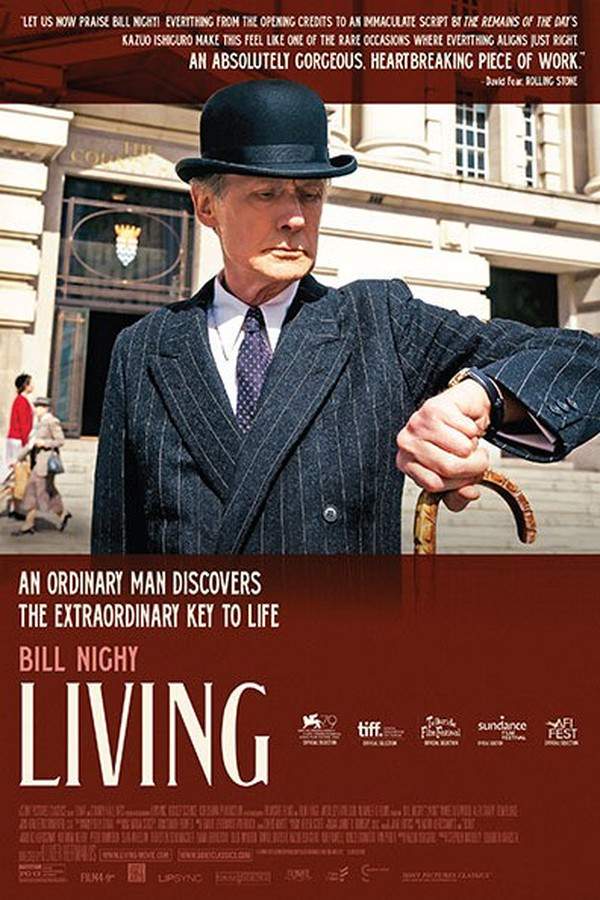
Living 2022
Directed by

Oliver Hermanus
Made by

Sony Pictures Classics
Test your knowledge of Living with our quiz!
Living Plot Summary
Read the complete plot summary and ending explained for Living (2022). From turning points to emotional moments, uncover what really happened and why it matters.
Rodney Williams is a dedicated bureaucrat working for the London County Council in the year 1953, feeling overwhelmed as he sits amidst towering stacks of paperwork, his inspiration seemingly depleted. A group of determined women, led by Mrs. Smith, approach the council with a heartfelt petition, seeking to transform a World War II bomb site into a children’s playground. However, their request is met with indifference, as the petition is shuffled from one department to another without any real consideration. When the petition ultimately lands on Mr. Williams’ desk, he adds it to his ever-growing pile, signaling to his colleagues his intention to take no meaningful action.
In a tragic turn of events, Mr. Williams learns of his terminal cancer diagnosis, yet he chooses to keep this news a secret from his son, Michael, and daughter-in-law, Fiona. Instead, he takes a drastic step, withdrawing half of his life savings and purchasing a fatal dose of sleeping medication with plans to end his life in a serene seaside resort. At the moment of decision, however, he finds himself unable to proceed with his plan and instead encounters Mr. Sutherland, an insomniac writer in a local restaurant, whom he gifts the sleeping medicine.
Moved by Mr. Williams’ poignant story, Sutherland takes him out for a memorable evening. During their escapade, Williams trades in his traditional bowler hat for a stylish fedora. At a pub, he unexpectedly connects with his past, singing “The Rowan Tree,” a Scottish folk song that resonates deeply with his childhood. Upon returning to London, although he avoids returning to work, Williams has a chance meeting with Miss Harris, a former colleague now working at a restaurant. Their lunch together is noticed by a meddlesome neighbor, causing Fiona to demand that Michael confront his father about potential gossip.
As time goes on, Williams struggles to convey his diagnosis to Michael, with both father and son unable to breach the subject clouded by unspoken emotions. As his health deteriorates, Williams increasingly cherishes the company of Harris, whose youthful enthusiasm he longs to regain. Realizing that he wants to leave a positive mark on the world, Williams inspires his office to take action in constructing the children’s playground that was once sidelined. He successfully advocates for the project, confronting his superiors to expedite the process, yet he tragically passes away shortly after its completion.
At his funeral, a heartfelt gathering of those he impacted, Michael speculates to Harris that his father may have confided in her about his condition, a revelation that leaves lingering questions. Motivated by Williams’ legacy, his former colleagues vow to change their ways, but the pressures of their roles quickly lead them back to their old habits. Mr. Wakeling, a new recruit in the office, discovers a letter left by Williams encouraging him to remember the playground during tough times. A visit to the playground reveals a heartwarming encounter when a police officer recounts seeing Williams enjoy a moment of solace there just before he died, swinging in the snow and singing “The Rowan Tree.” The officer grapples with guilt for allowing Williams to sit outside in his fragile condition, but Wakeling reassures him that in that moment, Williams was likely experiencing greater joy than he had in a long time.
Living Timeline
Follow the complete movie timeline of Living (2022) with every major event in chronological order. Great for understanding complex plots and story progression.
Rodney's Work Life
In 1953, Rodney Williams is depicted as a dedicated bureaucrat overwhelmed by his monotonous job at the London County Council. Surrounded by towering stacks of paperwork, he feels as if his inspiration has been depleted, struggling to make any meaningful impact in his work.
The Women's Petition
A group of determined women, led by Mrs. Smith, approaches the council to present a heartfelt petition. Their goal is to transform a World War II bomb site into a children's playground, but their request is met with indifference as it gets shuffled from department to department.
Rodney's Indifference
When the petition for the playground ultimately lands on Mr. Williams' desk, he adds it to his pile of paperwork without giving it any real consideration. This act symbolizes his resignation to the bureaucratic system and his reluctance to effect change.
A Grim Diagnosis
Rodney receives devastating news of his terminal cancer diagnosis, but he chooses to keep this devastating information a secret from his son Michael and daughter-in-law Fiona. This decision adds a heavy layer of emotional turmoil as he faces his mortality alone.
A Desperate Plan
In a drastic move, Rodney withdraws half of his life savings to purchase a fatal dose of sleeping medication, intending to end his life in a peaceful seaside resort. This moment of despair highlights the depth of his struggles with his terminal condition.
Meeting Mr. Sutherland
At the apex of his despair, Rodney encounters Mr. Sutherland, an insomniac writer in a local restaurant. Instead of going through with his plan, Rodney gifts Sutherland the sleeping medication, forging an unexpected bond over shared struggles.
A Night to Remember
Mr. Sutherland takes Rodney out for a memorable evening, which includes a change in Rodney's attire as he trades his bowler hat for a stylish fedora. This night serves as a brief escape from his grim reality, filled with laughter and connection.
A Touch of Nostalgia
While at a pub, Rodney sings 'The Rowan Tree,' a Scottish folk song from his childhood, tapping into memories of joy and innocence. This moment acts as a reminder of the vibrant life he once had, momentarily alleviating his burden.
A Chance Encounter
Upon returning to London, Rodney encounters Miss Harris, a former colleague now working in a restaurant. Their lunch together draws the attention of Fiona, who grows concerned about potential gossip regarding her father-in-law's well-being.
Struggles with Honesty
As time passes, Rodney finds it increasingly difficult to convey his cancer diagnosis to Michael. Both father and son navigate a complex emotional landscape, underscoring the struggles many families face when dealing with terminal illness.
Cherishing Connections
As Rodney's health declines, he develops a deep friendship with Miss Harris. Her youthful enthusiasm reignites a spark in him, bringing a sense of joy and purpose amidst the shadows cast by his illness.
Advocating for Change
Motivated by a desire to leave a positive legacy, Rodney rallies his colleagues to take action on the neglected children's playground project. He confronts his superiors, urging them to expedite the process and give the community something meaningful.
A Heartfelt Farewell
Tragically, Rodney passes away shortly after the children's playground project is completed. His death leaves a powerful impact on those around him, especially Michael and the women who fought for the playground.
The Funeral Gathering
At Rodney's funeral, a gathering of those he touched reflects on his life and legacy. Michael expresses to Harris his concern that his father may have shared his struggles with her, leaving behind questions about connections and communication.
The Playground Revelation
A new recruit named Mr. Wakeling finds a letter from Rodney that encourages him to remember the playground during tough times. The visit to the playground reveals a heartfelt connection when a police officer shares a touching memory of Rodney swinging joyfully just before his death.
Living Characters
Explore all characters from Living (2022). Get detailed profiles with their roles, arcs, and key relationships explained.
Rodney Williams
Rodney Williams is a dedicated bureaucrat caught in the throes of a mundane existence, marked by his overwhelming workload and emotional burden. Faced with a terminal cancer diagnosis, he embarks on a journey of self-discovery, seeking redemption by advocating for a children's playground. His transformation reveals a deep longing for connection and purpose in his final days.
Mrs. Smith
Mrs. Smith is a determined and spirited leader of a group advocating for change within their community. She represents the voice of the people, embodying the desire for improvement and the challenges faced when confronting bureaucracy. Her initiative to transform a bomb site into a playground highlights her resilience and commitment to enhancing children's lives.
Peter Wakeling
Peter Wakeling is a new recruit in the bureaucratic office, representing a fresh perspective amidst the entrenched complacency. He discovers a letter from Mr. Williams, urging him to remember the project during difficult times. His character symbolizes hope for change and the continuity of Mr. Williams' legacy, reminding the audience of the impact one person can have.
Living Settings
Learn where and when Living (2022) takes place. Explore the film’s settings, era, and how they shape the narrative.
Time period
1953
The year 1953 was a significant time in post-war Britain, marked by recovery and change following World War II. Social issues were prevalent, with communities striving to rebuild and improve their environments. This historical context adds depth to Mr. Williams' dilemma and the struggles of those around him, emphasizing the themes of purpose and legacy.
Location
London, Seaside Resort
London is the bustling capital city of England, known for its rich history, diverse culture, and iconic landmarks. It serves as the backdrop for Mr. Williams' bureaucratic struggles and personal revelations. The seaside resort represents a contrasting serene escape, symbolizing both the protagonist's contemplation of life and his ultimate decision to seek peace.
Living Themes
Discover the main themes in Living (2022). Analyze the deeper meanings, emotional layers, and social commentary behind the film.
⚖️
Redemption
The theme of redemption is central to Mr. Williams' journey as he seeks to find meaning in his life amidst personal turmoil. His engagement with the children's playground project symbolizes his desire to leave a lasting impact, transforming his bureaucratic indifference into proactive efforts for change. This quest for redemption resonates with both his colleagues and family, instigating reflections on one’s legacy.
🕊️
Mortality
Mortality looms large in Mr. Williams' story as he grapples with his terminal cancer diagnosis. The narrative explores his emotional struggle and the weight of unspoken truths with his family. This theme highlights the importance of confronting one's fate and the desire for meaningful connections before one’s time runs out.
👪
Family
Family plays a crucial role in the film, depicting the strained relationship between Mr. Williams and his son, Michael. Their inability to openly communicate about deep-seated emotions reflects the challenges many families face. Throughout the narrative, the relationship embodies longing, love, and the need for understanding as they navigate grief and legacy.

Coming soon on iOS and Android
The Plot Explained Mobile App
From blockbusters to hidden gems — dive into movie stories anytime, anywhere. Save your favorites, discover plots faster, and never miss a twist again.
Sign up to be the first to know when we launch. Your email stays private — always.
Living Ending Explained
Unravel the ending of Living (2022) with our detailed explanation. Understand the final scenes, character fates, and unresolved questions.
In the end, Williams’ final act of building the children’s park becomes a powerful symbol of how he chose to live his last months. Despite his initial reluctance and the routinized, emotionless life he had led, Williams’ encounter with his mortality pushed him to leave a lasting positive impact. His efforts to ensure the park’s construction before he died show that he finally understood what truly matters—bringing happiness to others rather than merely fulfilling bureaucratic duties. Williams’ dedication inspires his colleagues to take their work more seriously, even though most revert to old habits. However, Williams himself remains the only one who keeps his commitment, exemplified by his decision to visit the park after his death, where he genuinely feels joyful swinging in the snow, despite risking his health. This act signifies that he finally embraced life fully, choosing authentic happiness over societal conventions and superficial success.
Ultimately, Williams’ journey is about recognizing the importance of genuine human connection, purpose, and joy in the fleeting span of life. His final project, the children’s park, stands as a testament to his transformation — from a man living a mechanical existence to someone who, in facing death, understood that living means caring for others and finding joy in simple acts. His legacy continues through the park and the impact it has on the community, inspiring others to rethink what it means to truly live. The film closes on the image of children laughing and playing in the park, a beautiful reminder that even in life’s brevity, meaningful acts and love can leave an enduring mark.
Living Spoiler-Free Summary
Discover the spoiler-free summary of Living (2022). Get a concise overview without any spoilers.
In post‑war London of 1953, the city hums with the quiet clatter of paperwork and the lingering echo of reconstruction. Within the austere walls of the London County Council, Rodney Williams spends his days surrounded by towering stacks of forms, his routine as methodical as the ticking of an old clock. The bureau’s corridors are lined with polite indifference, a place where ambition is measured in memos and the promise of progress feels as distant as a far‑off whistle. The film’s tone is gently melancholic, painted in muted colours that capture both the weight of history and the fragile hope of ordinary lives.
When a determined group of women, led by Mrs. Smith, presents a petition to transform a bomb‑scarred site into a children’s playground, Rodney is handed another item for his ever‑growing pile. The request sits like a small, unclaimed stone amid his routine, stirring a yearning he has long suppressed. Beneath his composed exterior, a quiet desire for meaning begins to surface—a longing to step beyond the confines of endless bureaucracy and to feel, at last, the pulse of something alive. The story hints at an internal battle between duty and the whispered promise of a richer, more vibrant existence.
As the days drift forward, Rodney finds himself drawn into brief, unexpected encounters—an insomniac writer, Mr. Sutherland, who offers a night of conversation, and a former colleague, Miss Harris, whose youthful energy seems to reflect the vitality he craves. These interactions are painted with a gentle humor and a touch of wistful romance, suggesting that even within the most regimented systems, moments of connection can spark profound change. The film invites viewers to wonder whether Rodney will discover a path that lets him truly live, or if the weight of his world will keep him tethered to the endless rows of paperwork.
Can’t find your movie? Request a summary here.
Movies with Similar Twists and Themes
Uncover films that echo the narrative beats, emotional arcs, or dramatic twists of the one you're exploring. These recommendations are handpicked based on story depth, thematic resonance, and spoiler-worthy moments — perfect for fans who crave more of the same intrigue.
Featured on this page

What's After the Movie?
Not sure whether to stay after the credits? Find out!
Explore Our Movie Platform
New Movie Releases (2025)
Famous Movie Actors
Top Film Production Studios
Movie Plot Summaries & Endings
Major Movie Awards & Winners
Best Concert Films & Music Documentaries
Movie Collections and Curated Lists
© 2025 What's After the Movie. All rights reserved.








